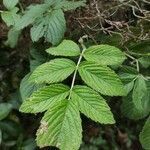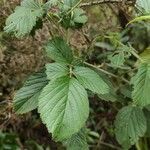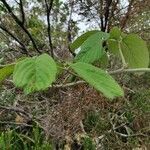Scrambling shrub to c. 1.5 m high. Flowering branches sparsely villous, brownish, with few to many decurved brownish-yellow prickles 2-5 mm long. Leaves 7-16 x 5.5-13 cm., 2-3-jugate or the uppermost ternate; petiole and rhachis villous and aculeate like the stems; lateral leaflets subsessile, terminal one with petiolule 1-2 cm long. Leaflets ovate-acute or elliptic-acute, with finely to coarsely serrate margin; superior surface brownish-green, thinly appressed-pilose; inferior surface pale brownish-green, villous on main veins and pilose between, or whitish-velutinous, the midrib very sparsely and minutely prickly, the lateral veins without prickles. Stipules narrowly linear. Inflorescences terminal and axillary, 3-19 cm long, broadly pyramidal to cylindrical, usually much longer than leaves, the branches spreading, villous and aculeate like the stem. Calyx greyish-tomentose, divided into narrowly triangular segments 4-6 mm long, ± clasping in fruit. Petals almost always absent, when present narrow, shorter than sepals, fugacious. Fruits globose, 0.5-0.8 cm long, purplish-black and edible when ripe; carpels relatively few (15-36), glabrous or rarely tomentose at the apex.
Leaflets ovate-acute or elliptic-acute, with finely to coarsely serrate margin; superior surface brownish-green, thinly appressed-pilose; inferior surface pale brownish-green, villous on main veins and pilose between, or whitish-velutinous, the midrib very sparsely and minutely prickly, the lateral veins without prickles.
A scrambling shrub. It grows 1.5 m high. The flowering branches have a few yellow or white hairs. The prickles are slender and curved. The leaves are 7-16 cm long by 6-13 cm wide. They have teeth along the edge. The fruit are round and 0.5-0.8 cm long. They are purplish-black. They are edible when ripe.
Leaves 7–16 x 5·5–13 cm., 2–3-jugate or the uppermost ternate; petiole and rhachis villous and aculeate like the stems; lateral leaflets subsessile, terminal one with petiolule 1–2 cm. long.
Scandent shrub. Leaves 5-7-foliolate, leaflets slightly discolorous, pubescent, venation on lower surface prominent. Corolla as long as or much shorter than calyx. Flowers pink and mauve.
Inflorescences terminal and axillary, 3–19 cm. long, broadly pyramidal to cylindrical, usually much longer than leaves, the branches spreading, villous and aculeate like the stem.
Fruits globose, 0·5–0·8 cm. long, purplish-black and edible when ripe; carpels relatively few (15–36), glabrous or rarely tomentose at the apex.
Flowering branches sparsely villous, brownish, with few to many decurved brownish-yellow prickles 2–5 mm. long.
Calyx greyish-tomentose, divided into narrowly triangular segments 4–6 mm. long, ± clasping in fruit.
Petals almost always absent, when present narrow, shorter than sepals, fugacious.
Scrambling shrub to c. 1·5 m. high.
Stipules narrowly linear.



